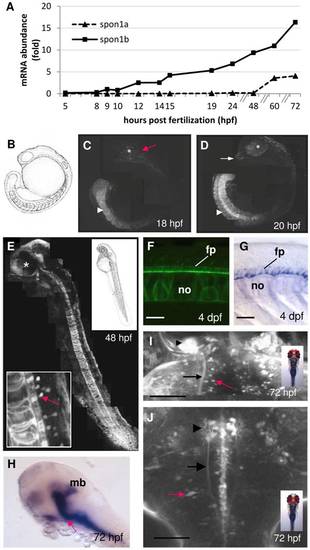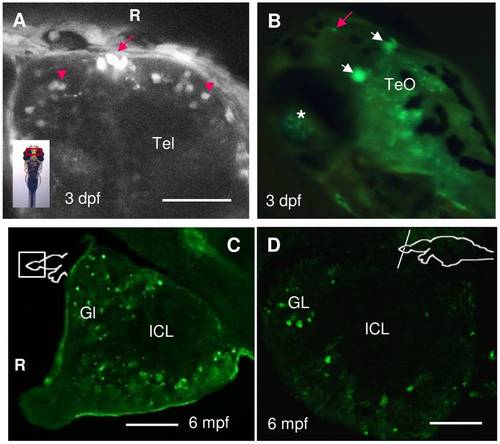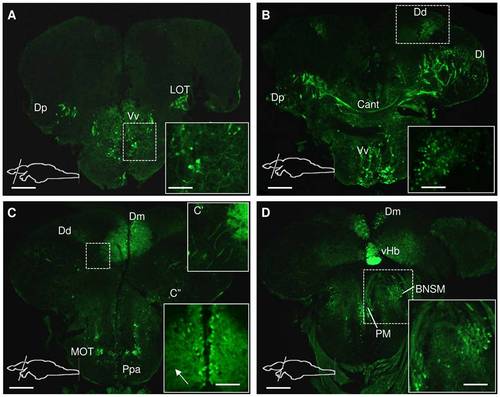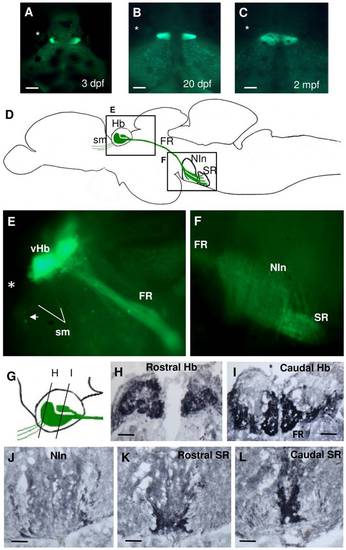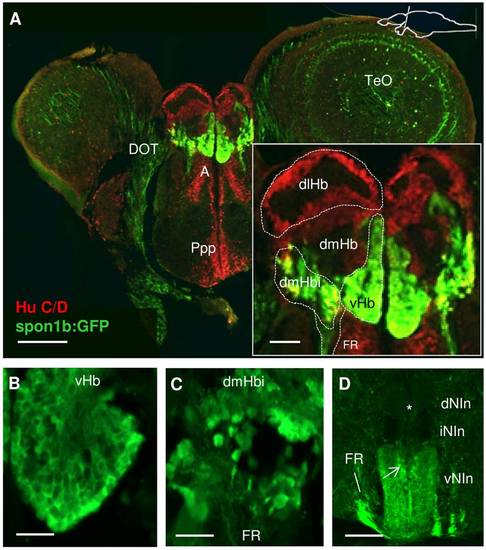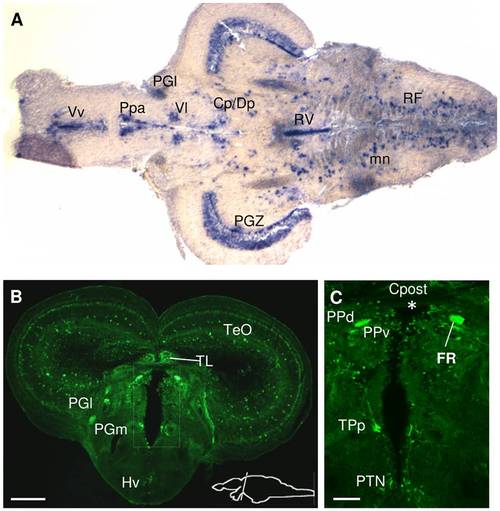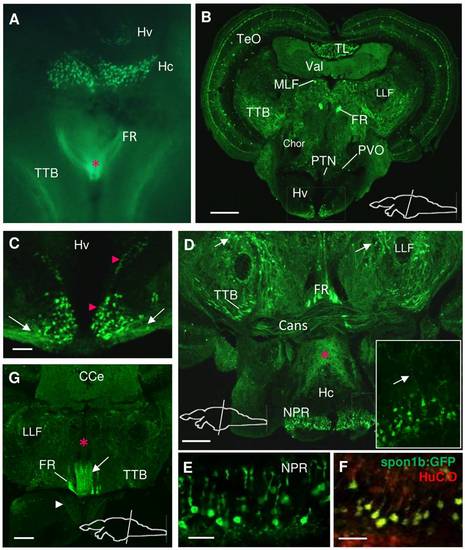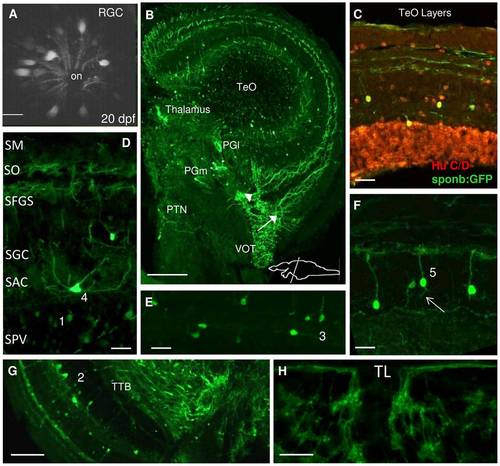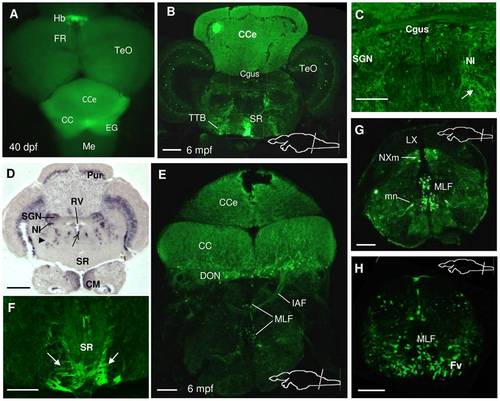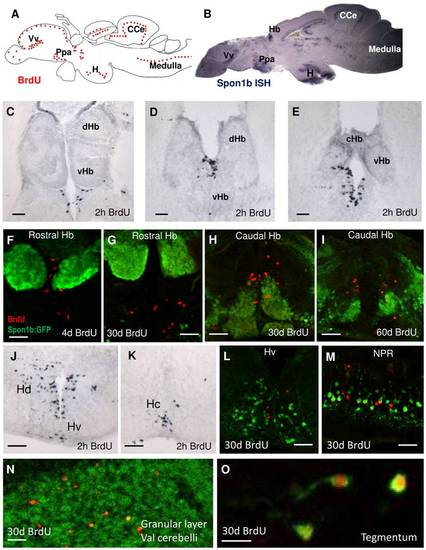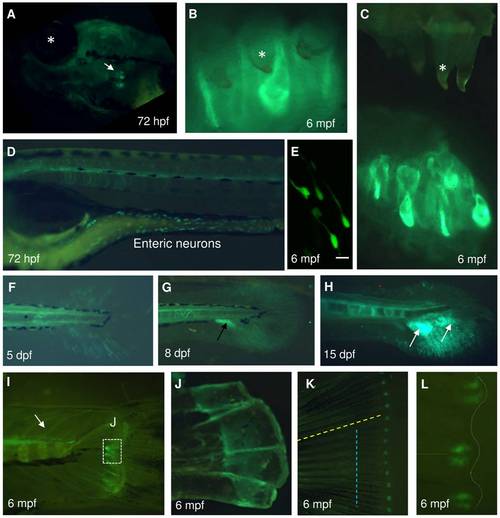- Title
-
F-Spondin/spon1b Expression Patterns in Developing and Adult Zebrafish
- Authors
- Akle, V., Guelin, E., Yu, L., Brassard-Giordano, H., Slack, B.E., and Zhdanova, I.V.
- Source
- Full text @ PLoS One
|
F-spondin expression during early zebrafish development. A. Onset of spon1a and spon1b expression during embryogenesis. Representative experiment showing mRNA abundance based on real-time RT-PCR (qPCR), with 1 fold corresponding to spon1b at 9 hpf. Zebrafish eggs fertilized at the same time (n>360) were sampled at intervals over a 72 h period (n = 30 embryos/larva per time point) and mRNA abundance for both genes was quantified in each same. B. Embryo schematic, 18 hpf. C-D. Spon1b:GFP expression in the tail bud, notochord and myotomes (arrowhead), brain areas (red arrow), olfactory bulbs (OB, white arrow) and retina (asterisk) at 18 hpf (B) and 20 hpf (D). Photomontages of confocal images. E. Spon1b:GFP expression pattern at 48 hpf. Photomontage of confocal images, sagittal view, asterisk: eye. Inset: developing motor neurons of the spinal cord (red arrow), dorsal to floor plate and notochord. F-G. The floorplate and notochord highlighted by spon1b:GFP (F, live image, 4 dpf) and in situ hybridization for spon1b mRNA (G, 4 dfp). Notochord (no), floorplate (fp). H. Spon1b expression in the flexural organ (arrow), and midbrain (mb). (in situ hybridization, 4 dpf). Rostral end to the left. I. Dorsal view of the telencephalon (Tel) and TeO border at 3 dpf, showing spon1b expression in habenula (arrowhead), in the fasciculus retroflexus (FR) emerging from it (black arrow), and in individual cells of the TeO (red arrow). Confocal z-stack image. J. Dorsal view of midbrain-hindbrain area at 3 dpf showing spon1b:GFP in the developing nMLF (arrowhead), in MLF projections (arrow) and in motor neurons of the reticular formation, including Mauthner cells (red arrow). Rostral end is up in I-J. Confocal z-stack image. Scale bars: F-G: 25 μm; I-J: 100 μm. EXPRESSION / LABELING:
|
|
Expression of spon1b:GFP in the olfactory bulbs (OB) and telencephalon (Tel) of larval and adult zebrafish. A. Dorsal Tel of 3 dpf embryo, showing individual cells of the OB (red arrowheads), and a cluster of three oval midline cells at the OB-Tel boundary (red arrow). Confocal z-stack image. B. Latero-dorsal view of live larva, at 3 dpf, with robust spon1b:GFP expression in the oval cells of the Tel-OB boundary (red arrow), in the paired habenular nuclei (white arrows), in individual cells of the TeO, and in the eye, with retinal ganglion cells visible through the lens (asterisk). C-D. Sagittal (B) and coronal (C) sections of the adult OB showing spon1b-positive cells in the outer glomerular cell layers (GL), but not in the inner cell layers (ICL). R: rostral end, in A & C. Scale bars: A: 200 μm; C-D: 50 μm. EXPRESSION / LABELING:
|
|
Spon1b expression in the telencephalon of adult zebrafish. Immunostaining for GFP in Tg(spon1b:GFP), coronal sections from rostral (A) to caudal (D) end. A. Spon1b expression in the central nucleus of ventral Tel (Vv), and terminal projections of the lateral olfactory tract (LOT), medial to dorsal nucleus of dorsal Tel (Dp). Inset: thick projections of spon1b-positive cells in Vv. B. Spon1b expression in Vv and the lateral (Dl), posterior (Dp) and dorsal (Dd) nuclei of the dosal Tel. Inset: small positive cells in Dd surrounding sulcus ypsiloniformis. Cant: anterior commissure. C. Robust spon1b expression in the medial nucleus of the dorsal Tel (Dm) and in the medial olfactory tract (MOT). Inset C′: Thick and long projections, originating from LOT area. Inset C′′: medially located spon1b positive cells in Dm with thin and dense projections extending laterally throughout the nucleus (arrow). Ppa: parvocellular preoptic area D. Spon1b expression in the preoptic area. Inset: magnocellular nucleus (PM) and bed nucleus of stria medullaris (BNSM). Strong spon1b expression in the ventral habenula (vHb) (only the right vHb is visible). Scale bars: A-D: 200 Μm. Insets: 50 μm. EXPRESSION / LABELING:
|
|
Spon1b:GFP expression in the habenular nuclei and their projections. A-C. Dorsal view of live zebrafish showing migration of ventral habenular nuclei from lateral to medial position: 3 dpf (B), 20 dpf (C), and 2 mpf (D). Asterisk indicates the position of the eye. D. Schematic of DCP in adult zebrafish showing areas of spon1b:GFP expression (E and F) and depicting the habenula (Hb), its afferent projections within the stria medullaris (sm), its efferent projection: fasciculus retroflexus (FR), and target nuclei: interpeduncular nucleus (NIn), and superior raphe (SR). E-F. Para-sagittal cut through fresh-frozen adult Tg(spon1b-GFP) brain. GFP fluorescence highlights all DCP structures, including vHb nuclei, FR and sm (E). Also, cells of the bed nucleus of the stria medullaris (BNSM, arrow in E), and projections to NIn and SR in F. Rostral to the left. G. Schematics of the relative shape and position of the spon1b-positive nuclei of the Hb, as shown in H-I. H-L. Coronal sections immunostained for GFP: rostral (H) and caudal (I) Hb, NIn (J), and rostral (K) and caudal (L) SR. Scale bars: A-B: 100 μm; D: 25 μm; H-L: 50 μm. EXPRESSION / LABELING:
|
|
Expression of spon1b and Hu C/D in the habenula (Hb) complex. A. Coronal section through the Hb showing spon1b:GFP immunoreactivity in green and the pan-neuronal marker Hu C/D in red. Note spon1b negative areas at this level: Anterior nucleus of thalamus (A), posterior preoptic areas (ppp). Inset to (A): schematic subdivisions of the Hb in spon1b-positive ventral nucleus (vHb), inferior nucleus of dorsomedial zone (dmHbi), and spon1b-negative dorsolateral (dlHb) and dorsomedial (dmHb) zones. B-C. High magnification images of the small densely packed cells in vHb (B) and the larger sparse cells in dmHbi (C). D. Coronal view of the interpeduncular nucleus (NIn) showing spon1b-positive terminal projections to the ventral area (vNIn), but not the dorsal and intermediate Nin (dNIn, iNIn) (asterisk). Note bypassing fibers from FR circumventing NIn on its way to the SR, and spon1b-positive cells at the core of Nin (arrow). Scale bars: A: 200 μm, inset: 50 μm; B-C: 25 μm; D: 100 μm. EXPRESSION / LABELING:
|
|
Spon1b expression in thalamic and pretectal regions. A. Horizontal section showing spon1b mRNA-positive nuclei (in situ hybridization): dorsoposterior (DP), centroposterior (CP) and ventrolateral (Vl) thalamic nuclei; anterior parvocellular preoptic (Ppa); Ventral Tel (Vv). B. Coronal section through the thalamus, immunostained for GFP. Medial (PGm) and lateral (PGl) preglomerular nuclei, torus longitudinalis (TL), ventral hypothalamus (Hv), optic tectum (TeO). C. Periventricular region (boxed area in B in adjacent section), showing spon1b-positive cells in the dorsal (PPd) and ventral (PPv) periventricular pretectal nuclei, in the posterior tuberculum (TPp), in the posterior tuberal nucleus (PTN) and in fibers of the fasciculus retroflexus (FR). Note absence of signal in the subcommissural organ (asterisk: SCO region, ventral to posterior commissure, Cpost). Scale bars: A-B: 100 μm; C: 50 μm. EXPRESSION / LABELING:
|
|
Spon1b expression in the hypothalamic area. A. Ventral view of a freshly-dissected adult Tg(spon1b-GFP) brain: fluorescence signal in the ventral (Hv) and caudal (Hc) hypothalamic nuclei, the tectobulbar tract (TTB), the interpeduncular nucleus and superior raphe (asterisk), and fibers from the fasciculus retroflexus (FR). B. Coronal section at the level of the ventral hypothalamus (Hv), immunostained for GFP. Note the strong fluorescence signal in FR and medial longitudinal fasciculus (MLF), but its absence in the horizontal commissure (Chor) and lateral lemniscus (LLF). Optic tectum (TeO), posterior tuberal nucleus (PTN), paraventricular nucleus (PVO), torus longitudinalis (TL), valvula cerebelli (Val). C. Spon1b expression in periventricular cells (arrowheads) of the Hv nucleus (boxed area in B) with long projections extending laterally (arrows). D. Coronal section at the level of the caudal hypothalamus (Hc) showing high spon1b expression in the nucleus of the posterior recess (NPR), and long projections within the dorsal hypothalamus (asterisk). These projections, in part, originate from the most lateral cells of the NPR (arrow in inset). Note strong signal in scattered cells and projections in the tegmentum (arrows), ansulate commissure (Cans), and tectobulbar tract (TTB). E. Robust spon1b expression in the NPR. Note the dorsal projections of CSF-contacting neurons. F. Cells in NPR showing co-localization of the pan-neuronal marker Hu C/D (red) and spon1b:GFP (green). G. Coronal section at the level of NIn showing spon1b:GFP in vNIn (white arrow), but its absence in dorsal NIn (dNIn, red asterisk). Spon1b-positive fibers in the cerebellar corpus (CCe), FR (fibers circumventing NIn on the way to SR), mammillary bodies (arrowhead) and TTB. Scale bars B,G: 100 μm; C: 25 μm, D: 50 μm; E-F: 20 μm. EXPRESSION / LABELING:
|
|
Spon1b expression in areas of the visual system. A. Spon1b expression in retinal ganglion cells (RGC) forming optic nerve (on) in live zebrafish at 20 dpf. Confocal image. B. Coronal section of adult zebrafish fish brain at the level of the optic tectum (TeO) showing spon1b-positive retino-tectal projections of the ventrolateral optic tract (VOT) splitting into two TeO layers: stratum fibrosum et griseum superficiale (SFGS, arrow) and stratum opticum (SO, arrowhead). Spon1b-positive cells in the medial (PGm) and lateral (PGl) preglomerular nuclei, and in the posterior tuberal nucleus (PTN). C. Double immunostaining in TeO demonstrates co-localization of spon1b:GFP (green) and Hu C/D (red) signal, confirming the neuronal nature of spon1b-positive cells. D. Coronal section identifying six TeO layers, with spon1:GFP expression in retinotectal projections in SO and SFGS, cell types 1 (in SPV border) and 4 (in SAC). E. Type 3 TeO cell, with horizontal projections in the SAC layer. F. Type 5 TeO cells with vertical projections in the SGC layer. G. Type 2 TeO cell with vertical projections traversing all TeO layers and forming the tectobulbar tract (TTB). H: Spon1b-positive cells and rami-like neuropil in the torus longitudinalis (TL). Scale bars: A: 10 μm; B: 100 μm; E-F: 15 μm; D,H: 20 μm, G: 50 μm. EXPRESSION / LABELING:
|
|
Spon1b expression in the hindbrain. A. Dorsal view of a freshly-dissected Tg(spon1b:GFP) juvenile zebrafish showing relative position of the paired habenular nuclei (Hb), emerging fasciculus retroflexus (FR), optic tectum (TeO), cerebellar corpus (Cce), granular eminence (EG), and medulla (Me). B. Coronal section of adult zebrafish brain at the level of the cerebellar corpus showing spon1b:GFP positive projections within the cerebellum, and to the superior raphe (SR). Tectobulbar tract (TTB). C. Spon1b:GFP signal in cells of the secondary gustatory nucleus (SGN), in the gustatory commissure (Cgus), and in scattered cells and projections throughout the tegmentum (arrow), and nucleus isthmi (NI). (High magnification picture of area in B). D. Spon1b mRNA expression (in situ hybridization) in Purkinje cell layer (Pur), ventral tip of rhomboencephalic ventricle (rv), SGN, nucleus isthmi (NI), superior reticular nucleus (arrowhead) and mammillary bodies (CM). Note the lack of signal in the Cgus and SR, confirming that the spon1b:GFP label in these regions comes from projections and not cell bodies. E. Coronal section at the level of the caudal cerebellum showing spon1b-positive cells and thick projections from cerebellar crest (CC), the descending octaval nuclei (DON) and the commissure that joins the nuclei, the internal arcuate fibers (IAF) coursing in between the axons of the medial longitudinal fasciculus (MLF). F. Spon1b-positive FR fibers (arrows) terminating on both sides of the ventral region of SR (high magnification image of area boxed in B). G. Coronal section at the level of the caudal medulla showing spon1b:GFP expression in the vagal motor nucleus (NXm), but not in the vagal lobe (LX). Note the symmetrically labeled motor neurons (mn), and the strongly labeled axons of the MLF and motor neuron axons in the ventral funiculus (Fv). H. Coronal section of the spinal cord showing spon1b:GFP expression in the axons of MLF and the ventral funiculus (Fv). Scale bars: B, F-H: 100 μm; C-D: 50 μm; E: 200 μm. EXPRESSION / LABELING:
|
|
Spon1b is expressed in neurogenic niches. A. Schematic of neurogenic niches in zebrafish brain based on BrdU immunostaining and modified from Grandel et. al. (2006). Cerebellar corpus (CCe), Habenula (Hb), hypothalamic areas (H), parvocellular preoptic area (Ppa), thalamic area (T), ventral nucleus of ventral telencephalon (Vv). B. Mid-sagittal of adult zebrafish brain showing spon1b mRNA expression (in situ hybridization). Note the overlap of the spon1b-positive areas with the neurogenic niches. C-E. BrdU-positive nuclei in the habenular niche in rostral (D), and mid (E) and caudal (F) areas, 2 hours post-BrdU injection. F-I. Double immunostaining of the habenular niche, showing spon1b- (green) and BrdU- (red) positive cells, at 4d (F), 30d (G-H) and 60d (I) post BrdU-injection, showing migration of the BrdU nuclei away from the niche and into the surrounding tissue. J-K. BrdU nuclei in the ventral (J) and caudal (K) hypothalamus, Hv and Hc, respectively, 2 hours post-injection. L-M. Double immunostaining for BrdU (red) and spon1b:GFP (green) 30 days post BrdU injection in ventral hypothalamus (Hv, L), and in the nucleus of the posterior recess (NPR) in Hc (M) showing lack of co-localization. N. Double immunostaining for BrdU (red) and spon1b:GFP (green) 30 days post BrdU injection in the cerebellum. Note the BrdU-positive nuclei among the spon1b-positive fibers. O. Co-localization of BrdU (red) and spon1b:GFP (green) in cells extending long projections in the tegmentum 30 days post-BrdU injection. Scale bar C: 200 μm, D-L,N: 50 μm, M: 20 μm. EXPRESSION / LABELING:
|
|
Spon1b expression in peripheral tissues of Tg(spon1b:GFP). A. Spon1b expression in pharyngeal teeth of zebrafish larvae at 3dpf (arrow). Asterisk: eye. B-C. Pharyngeal teeth in adult zebrafish with spon1b:GFP expressed in newly developing teeth. Asterisk: old mineralized teeth. Green signal: spon1b-positive soft tissue. In C, soft tissue is moved off the hard tissue. D. Spon1b:GFP positive enteric neurons in intestine of developing larva, 72hpf (sagittal view of live specimen). E. Spon1b:GFP positive enteric neurons in adult zebrafish (confocal z-stack). F-H. Progression of spon1b expression in larval tail. Expression in larval fin rays at 5 dpf (F). Development of the adult tail primordium (arrow) by 8 dpf (G). Subsequent splitting into 2 domains (arrows in H, 15 dpf) that will give rise to the two adult caudal fin lobes. I. Spon1b expression in the endoskeleton of the adult zebrafish caudal fin. Note spon1b-positive axons of the motor neurons traversing the trunk and musculature (arrow). J. Dissected endoskeleton in (I), showing a thin sheet of spon1b-positive tissue covering the bone. K. Spon1b signal at the distal end of the growing adult tail 4 days post caudal fin amputation. Blue line shows the level of amputation and yellow line marks a growing lepidotrichium. L. High magnification image of region in (K) showing the two spon1b-positive domains of blastema, patterning each growing lepidotrichium (yellow line). White line: distal edge of regenerating caudal fin. Scale bars: 20 μm. EXPRESSION / LABELING:
|

Unillustrated author statements |

